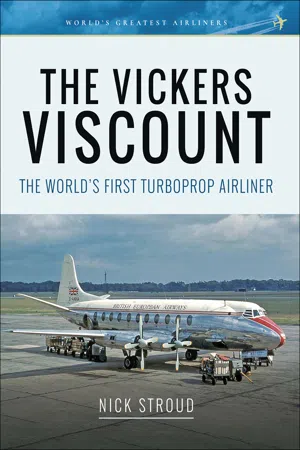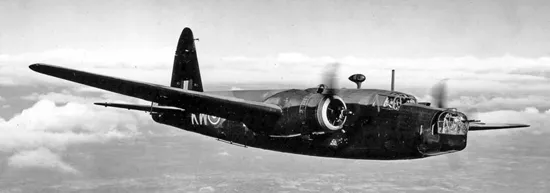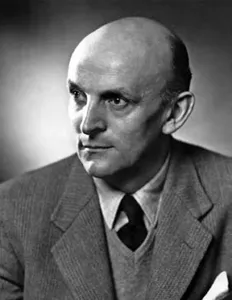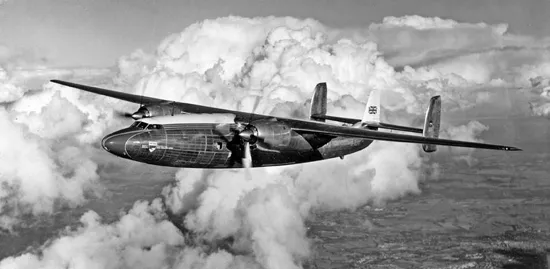
- 120 pages
- English
- ePUB (mobile friendly)
- Available on iOS & Android
eBook - ePub
About this book
By some margin the most successful British medium-range airliner ever produced, the world-beating Viscount was a sublime combination of Vickers state-of-the-art postwar design and Rolls-Royces cutting-edge power-plant technology, both companies being at the very peak of their powers during the types genesis and evolution.Tracing its origins back to the wartime Brabazon Committee, the Viscount was one of several designs from various British aircraft manufacturers produced to fulfill the committees specifications for a fast, economical short- to medium-range airliner to satisfy the demands of the burgeoning postwar civil aviation market, which was predicted to grow at a healthy rate over the following decades. Vickers chief designer and Managing Director George Edwards was quick to respond, the result being the Dart turboprop-powered Vickers V.630, which made its first flight in July 1948, despite its future looking uncertain after British European Airways having twenty examples of ordered its chief rival, Airspeeds Ambassador, six months before. The Viscount nevertheless entered full service with BEA in 1953, much to the relief of its manufacturer, orders flooding in thereafter from numerous airlines and air forces all over the world. Ultimately, some 200 individual airlines, companies and organizations in more than eighty countries operated the dependable and, crucially, development-friendly Viscount over its long and distinguished career.This book tells the full story of the worlds first turboprop airliner, from its Brabazon Committee beginnings, through its early flight trials program and entry into service, to its almost unassailable position as the worlds number one medium-haul turboprop, including its astonishing breakthrough in the USA, where it single-handedly broke the big American manufacturers stranglehold on the airliner market. The types military career is also covered, as is its construction; also included in this volume are details of the numerous variants produced and those of the 444 built still surviving as exhibits today, along with twenty-four superb artworks by world-renowned aviation illustrator Juanita Franzi.
Frequently asked questions
Yes, you can cancel anytime from the Subscription tab in your account settings on the Perlego website. Your subscription will stay active until the end of your current billing period. Learn how to cancel your subscription.
At the moment all of our mobile-responsive ePub books are available to download via the app. Most of our PDFs are also available to download and we're working on making the final remaining ones downloadable now. Learn more here.
Perlego offers two plans: Essential and Complete
- Essential is ideal for learners and professionals who enjoy exploring a wide range of subjects. Access the Essential Library with 800,000+ trusted titles and best-sellers across business, personal growth, and the humanities. Includes unlimited reading time and Standard Read Aloud voice.
- Complete: Perfect for advanced learners and researchers needing full, unrestricted access. Unlock 1.4M+ books across hundreds of subjects, including academic and specialized titles. The Complete Plan also includes advanced features like Premium Read Aloud and Research Assistant.
We are an online textbook subscription service, where you can get access to an entire online library for less than the price of a single book per month. With over 1 million books across 1000+ topics, we’ve got you covered! Learn more here.
Look out for the read-aloud symbol on your next book to see if you can listen to it. The read-aloud tool reads text aloud for you, highlighting the text as it is being read. You can pause it, speed it up and slow it down. Learn more here.
Yes! You can use the Perlego app on both iOS or Android devices to read anytime, anywhere — even offline. Perfect for commutes or when you’re on the go.
Please note we cannot support devices running on iOS 13 and Android 7 or earlier. Learn more about using the app.
Please note we cannot support devices running on iOS 13 and Android 7 or earlier. Learn more about using the app.
Yes, you can access The Vickers Viscount by Nick Stroud in PDF and/or ePUB format, as well as other popular books in History & British History. We have over one million books available in our catalogue for you to explore.
Information
CHAPTER 1 Genesis
THE ORIGIN OF what would ultimately be one of the greatest success stories of Britain’s post-war aircraft industry dates back to a resolutely optimistic appraisal undertaken by a committee convened in the dying days of 1942 to discuss what the nation’s post-war civil aircraft needs might be – a bold course of action at a time when the successful conclusion of the war against the Axis powers was far from certain.
Although Britain had been responsible for some of the most successful civil aircraft of the pre-war period, the outbreak of war in Europe in 1939 had forced the redeployment of the nation’s resources on to a war footing, the development of commercial aircraft having to be set aside in order to accommodate the mass production of warplanes for the impending conflict. This enormous acceleration in the production of fighters, bombers and other vital military types would, however, take some time to gather momentum, and in the interim Britain would be in desperate need of aircraft to bridge the gap. The nation’s air arms had secured a temporary respite during the crucial Battle of Britain — but only by the narrowest of margins. Hard times were ahead, and to keep Britain’s forces bolstered against those of Nazi Germany, the USA abandoned all pretence of impartiality, and in March 1941 enacted its Lend-Lease policy, in which food, oil and, importantly, military materiel would be supplied to nations facing the Axis war machine, most notably the UK. America was yet to become embroiled in the conflict and, in contrast to Britain, was still very much in the transport aircraft business; the USA would continue to develop civil types even after declaring war on Japan, Germany and Italy in December 1941. An important proviso of Lend-Lease, however, was that all materiel received was, on the cessation of hostilities, to be paid for in full, returned to the USA or destroyed. The thousands of transport aircraft received by the British as part of Lend-Lease, eminently convertible for commercial use, could not therefore be used as the backbone for the UK’s post-war airline industry.
Aware of this prospective handicap and showing remarkable prescience, the British government established a committee in the autumn of 1942 to devise a post-war civil aviation strategy. It was to be led by Lord Brabazon of Tara, the first person in Britain to be awarded a Royal Aero Club Aviator’s Certificate, in 1910, and formerly Minister of Transport during 1940–41 and Minister of Aircraft Production during 1941–42. Brabazon was tasked with organising an advisory committee to formulate plans for the procurement of suitable aircraft and the re-establishment of international air services, which, it was forecast, would continue operations over the pre-war routes to the furthest-flung reaches of the British Empire.
The first meeting of the Brabazon Committee was held on December 23, 1942, and was attended by Brabazon, three representatives from the Air Ministry and three from the Ministry of Aircraft Production, who over the next few months would shape the basic template of requirements that the post-war civil aircraft industry would have to meet. A second committee was established in the spring of 1943 to dig deeper into detail, the eight-man panel comprising individuals from industry, the relevant ministries and the British Overseas Airways Corporation (BOAC). Mention had already been made by the first committee of “an economical [Douglas] DC-3 replacement for European services”, and after a number of iterations discussed by the Brabazon Committee and the new Ministry of Civil Aviation, established in November 1944, this eventually metamorphosed into requirement IIB, a sub-section of the second of five types outlined in the Brabazon Committee’s final report of 1945. Requirement II was for a medium-range 24-seat pressurised transport aircraft, the B suffix denoting that it was to be powered by four gas-turbine (turboprop) engines, a form of technology which at that time was untried and still very much in development, but which Vickers nevertheless felt showed a great deal of promise.

Having first flown in December 1935, the Douglas DC-3 became ubiquitous in service with airlines all over the world, particularly after the Second World War, when the type became readily available from surplus military stocks, and at affordable prices for fledgling airlines. One of the chief specifications set out by the wartime British Brabazon Committee was for a homegrown DC-3 replacement that could serve the nation’s post-war domestic and short-haul routes, and it was with this in mind that Vickers conceived what would eventually become the Viscount. (The Aviation Historian Archive)

Originally designed to a 1932 specification for a long-range twin-engined bomber, the Vickers Wellington first flew in June 1936 and provided sterling service for the RAF throughout the Second World War, despite being obsolete in comparison to its younger four-engined service-mates, the Avro Lancaster and Handley Page Halifax. The type was nevertheless a great success for Vickers, more than 11,460 examples being built. It was the only RAF bomber to be produced for the duration of the war, and was one of the few types to be in front-line service both when war broke out in 1940 and when the war ended in 1945. (The Aviation Historian Archive)

One of the most important captains of Britain’s postwar aviation industry, George (Sir George from 1957) Edwards joined Vickers at Weybridge as a draughtsman in 1935, rising to Experimental Works Manager in 1940 and Chief Designer in June 1945. He would go on to be responsible for the development of the highly successful Viscount airliner and Valiant V-bomber, and eventually became Vickers’ Managing Director in 1955. He would also play an important part in the development of Concorde after Vickers became part of the British Aircraft Corporation in 1960. (The Aviation Historian Archive)
By mid-1944 Vickers had already seen the writing on the wall and started the development of the Vickers Commercial 1 (VC1), a civil development of its ageing but dependable Wellington twin-engined bomber, which had seen service since the first days of the war. The Wellington’s distinctive geodetic fuselage construction was replaced with a more modern stressed-skin fuselage and inner-wing sections, but initially retained the geodetic fabric-covered outer wings and tailplane of its military progenitor. The first prototype Vickers V.491 VC1 Viking, registered G-AGOK, made its first flight on June 22, 1945, from the company’s airfield at Wisley, and the first production V.498 Viking commenced operational trials with BOAC from May 1946.
With the Ministry of Aircraft Production’s approval, Vickers then set to work on the IIB proposal, with an initial design forthcoming in June 1945 from the company’s chief designer, R.K. “Rex” Pierson, who would be promoted Chief Engineer of Vickers-Armstrongs that September, George (later Sir George) Edwards filling his shoes thereafter. The June 1945 concept, designated VC2, incorporated a portly “double-bubble” pressurised fuselage seating 24 passengers three abreast, 88ft (26·8m)-span wings, a fin similar to that of the Viking and four Rolls-Royce Dart engines which it was anticipated would provide a cruising speed of some 300 m.p.h. (480km/h) over a range of more than 1,000 miles (1,609km). Although comparatively little of it would be retained in what would become one of the most distinctive shapes in British airliner history, the bones of the Viscount were already clearly visible in this early design.
The arrival of Edwards as chief designer in September 1945 led to a number of substantial changes to the VC2 design, including the replacement of the double-bubble fuselage with a more conventional circular-section design capable of accommodating four-abreast seating, wings of equal straight taper, a dihedral tailplane and generously proportioned elliptical cabin windows, all of which would be retained on all variants of the final product. Progress with the various turboprop powerplants being developed concurrently had slowed, however, and it was Armstrong Siddeley’s Mamba that was selected by the Ministry of Supply (MoS) when it placed its official order for two prototype VC2s in March 1946 to Specification 8/46, although Vickers continued to pin its hopes on the Dart throughout the procurement process.

Using the Wellington as a basic blueprint, Vickers’ chief designer R.K. “Rex” Pierson initially retained the bomber’s fabric-clad geodetic wing and tail unit to create the VC1 Viking, which incorporated a new metal fuselage capable of accommodating up to 24 passengers, although later versions had metal wings and empennages and could be configured for up to 36 passengers. Production stopped in 1948, by which time 163 examples of the piston-engined airliner had been built. (The Aviation Historian Archive)

(John Havers Collection via The Aviation Historian Archive)
Another significant milestone was reached in August 1946 with the establishment of British European Airways (BEA), a nationalised corporation responsible for domestic and international short-haul air services, and the prime customer for the new Vickers turboprop, which was designated V.609 and named Viceroy that November. The new airline immediately began consultations with Vickers, stipulating that it estimated a requirement for 75 aircraft capable of carrying 32 passengers over short- to medium-haul routes, prompting further changes to the VC2, including increased span and length to accommodate more passengers, although the Mamba powerplants were retained. Vickers still advocated the use of the Dart, however, and in August 1946 elected to build, as a private venture, another prototype powered by the Rolls-Royce engine, although by August the following year the MoS had relented and authorised Vickers to build the original prototype with Darts, the manufacturer redesignating it V.630. A scheme was also put forward in which the type would be powered by a Dart in each inner engine nacelle and a Rolls-Royce Nene turbojet on each of the outers, but this expensive and unnecessarily complicated idea ultimately came to nothing.
August 1947 not only saw a change in powerplant for the new airliner, but a change in name too. The Partition of India was officially declared on August 14–15, consigning the post of British Viceroy to history, and it was felt that the alternative name Viscount was similarly honourable and alliterative, and was adopted forthwith. By the end of 1947 the new Vickers design was shaping up into a sophisticated modern airliner, and the Dart engine was finally making good progress in its extensive flight-testing programme, which had started with its fitting in a number of test-beds from that October.

Arguably more elegant than its turboprop-powered Vickers rival, the piston-engined triple-tailed Airspeed Ambassador first flew in July 1947 and entered service with British European Airways (BEA) as the “Elizabethan Class” in 1952. Pressurised and offering spectacular views for passengers by virtue of its high-mounted wing, the 45–50-seat Ambassador was initially extremely popular with the public, but the superior efficiency and speed of new turboprops like the Viscount ensured that only 23 examples were built, and the BEA fleet had been retired by the end of 1958. Other operators such as Dan-Air, Autair and BKS Air Transport were swift to snap up those that remained airworthy and some of these remained in service well into the 1960s, Dan-Air retiring its last remaining example in 1971. (The Aviation Historian Archive)
So it came as something of a hammer-blow when BEA indicated in December 1947 that it would be ordering 20 examples of the larger Airspeed Ambassador, designed to Brabazon requirement IIA, essentially the same as that of the Viscount, but with piston engines. Unsurprisingly, with no firm orders from any airline and a kick in the teeth from the company’s biggest hope for its new airliner, Vickers’ work on the Viscount slowed down to a dribble with the attendant effect on the team’s morale. The new airline had repeatedly expressed its concern that the Vickers type was too small and presented too great a risk with its unproven Dart turboprops, resulting in a re-examination of the design in mid-1947 by Edwards, who came up with a number of revisions, including a larger wing carrying a pair of Bristol Hercules piston engines and a larger 40-seat version with four Darts, the Rolls-Royce engine having finally begun to fulfil its promise. Neither of these revised designs was approved by the MoS, however, and Vickers was instructed to continue with the original prototype – the V.630, with Darts – as mentioned above.
Production of the second prototype slowed down, but work continued on the first at Foxwarren, Vickers’ experimental works near its main factories at Weybridge and Wisley. On completion, the first fuselage was transferred to Wisley for final assembly, and in June 1948 the first prototype, registered G-AHRF...
Table of contents
- Cover
- Title
- Copyright
- Contents
- Introduction
- Chapter 1 Genesis
- Chapter 2 Development
- Chapter 3 Into service
- Chapter 4 Anatomy
- Chapter 5 The final variants
- Chapter 6 Into uniform
- Chapter 7 ‘Twas a dark and stormy night …’
- Chapter 8 A long career
- Chapter 9 Survivors
- Chapter 10 Viscount colours
- Acknowledgements